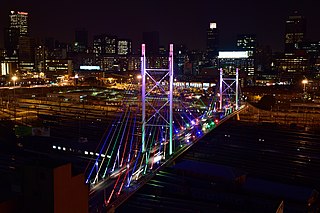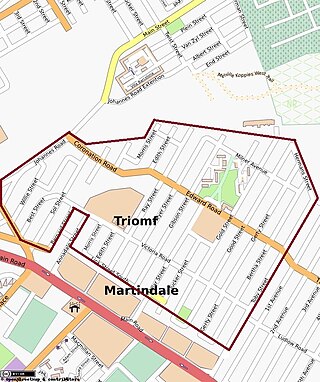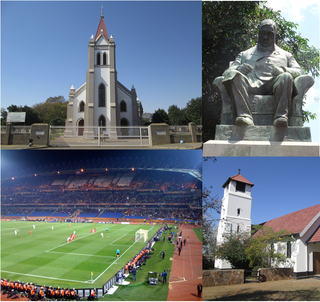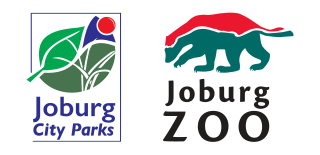
Johannesburg is the most populous city in South Africa with 4,803,262 people, and is classified as a megacity; it is one of the 100 largest urban areas in the world. It is the provincial capital of Gauteng, the wealthiest province in South Africa. Johannesburg is the seat of the Constitutional Court, the highest court in South Africa. Most of the major South African companies and banks have their head offices in Johannesburg. The city is located within the mineral-rich Witwatersrand hills, the epicentre of the international-scale mineral, gold and (specifically) diamond trade.

Gauteng is one of the nine provinces of South Africa.
The area referred to as Fourways is the fastest-developing commercial and residential hub in Sandton, north of Johannesburg, South Africa. The main access routes to Fourways are off the N1 at R511 Winnie Mandela Drive, or alternatively along R564 Witkoppen Road. It is located mostly in Region E of the City of Johannesburg Metropolitan Municipality. It is roughly as far as one can go in the Johannesburg Metropolitan area before it dissolves into rolling hills, game farms and the capital Pretoria, 55 kilometres to the northeast. Hartebeespoort Dam and the Magaliesberg Mountains lie half an hour to the north-west. It is bordered by Bryanston to the east and south and Randburg to the west.

Sophiatown, also known as Sof'town or Kofifi, is a suburb of Johannesburg, South Africa. Sophiatown was a poor multi-racial area and a black cultural hub that was destroyed under apartheid. It produced some of South Africa's most famous writers, musicians, politicians and artists, like Father Huddleston, Can Themba, Bloke Modisane, Es'kia Mphahlele, Arthur Maimane, Todd Matshikiza, Nat Nakasa, Casey Motsisi, Dugmore Boetie, and Lewis Nkosi.

Roodepoort is a city in the Gauteng province of South Africa. Formerly an independent municipality, Roodepoort became part of the Johannesburg municipality in the late 1990s, along with Randburg and Sandton. Johannesburg's most famous botanical garden, Witwatersrand National Botanical Gardens, is located in Roodepoort.

Rustenburg is a city at the foot of the Magaliesberg mountain range. Rustenburg is the most populous city in North West province, South Africa. In 2017, the city's Gross Domestic Product (GDP) reached ZAR 63.8 billion, accounting for 21.1% of the GDP of the North West Province, and 1.28% of the GDP of South Africa. Rustenburg was one of the official host cities of the 2010 FIFA World Cup, being in close proximity to Phokeng, the capital of the Royal Bafokeng Nation, where the Royal Bafokeng Stadium is located. The England national football team also used this as their base camp for the tournament.
Houghton Estate, often simply called Houghton, is an affluent suburb of Johannesburg, South Africa, north-east of the city centre.

The City of Johannesburg Metropolitan Municipality is a metropolitan municipality that manages the local governance of Johannesburg, the largest city in South Africa. It is divided into several branches and departments in order to expedite services for the city. Zulu is the most spoken home language at 23.4% followed by English at 20.1%.

The Johannesburg Zoo or Joburg Zoo is a 55-hectare (140-acre) zoo in Johannesburg, South Africa. The zoo is dedicated to the accommodation, enrichment, husbandry, and medical care of wild animals, and houses about 2000 individuals of 320 species. Established in 1904, it has traditionally been owned and operated by the Johannesburg City Council. However, it has been turned into a corporation and registered as a Section 21 non-profit organisation.
Parktown is a wealthy suburb of Johannesburg, South Africa, and is the first suburb north of the inner city. It is affectionately known as one of the Parks, others including Parkview, Parkwood, Westcliff, Parktown North, Parkhurst and Forest Town. Parktown is one of Johannesburg's largest suburbs, neighbouring Hillbrow, Braamfontein and Milpark to the South; Berea and Houghton to the East; Killarney and Forest Town to the North, and Westcliff, Melville and Richmond to the West. Originally established by the Randlords in the 1890s, Parktown is now home to many businesses, hospitals, schools, churches and restaurants, whilst still maintaining quiet residential areas. It is also home to three of the five campuses of the University of the Witwatersrand including the education campus, medical school and Wits Business School. It is located in Region F of the City of Johannesburg Metropolitan Municipality.

Commissioner Street is a major one-way street (westwards) in the Central Business District of Johannesburg, South Africa. It runs from the M31 to the R41, and is indicated as part of the R24. The Carlton Centre, the 2nd-tallest building in Africa, is located on the street, as is the southern end of Newtown. There is little evidence of Commissioner Street's exact origin, although it is known that this street played a role in the development of Johannesburg.

Torc Mountain, at 535 metres (1,755 ft), is the 329th–highest peak in Ireland on the Arderin list. It is a popular mountain for hill walkers as it has a stone or boarded path from its base at Torc Waterfall to its summit, which has views of the Lakes of Killarney. Torc Mountain is part of the Mangerton Mountain Group range in County Kerry, Ireland.

Torc Waterfall is a 20 metres (66 ft) high, 110 metres (360 ft) long cascade waterfall formed by the Owengarriff River as it drains from the Devil's Punchbowl corrie lake at Mangerton Mountain. The waterfall, which lies at the base of Torc Mountain, in the Killarney National Park, is 4.3 miles from Killarney in County Kerry, Ireland. The waterfall is a popular site on the Ring of Kerry and the Kerry Way tours.

The Johannesburg Botanical Garden is located in the suburb of Emmarentia in Johannesburg, South Africa. The gardens grew out of a large rose garden that was established in 1964 and subsequently expanded from 1969 to cover an area of around 125 hectares (1.25 km2). It is administered by Johannesburg City Parks. The Emmarentia Dam is situated immediately to the east of the garden and shares its extensive acreage. One of the main attractions is the Rose Garden with over 10 000 roses.

Johannesburg City Parks and Zoo (JCPZ) is a not-for-gain company established under Section 21 of the South African Companies Act and wholly owned by the City of Johannesburg.

Emmarentia Dam is a dam in Emmarentia, Johannesburg, South Africa. There are several dams that make up Emmarentia Dam, despite its allusion to the singular, with two small dams found upstream in the Johannesburg Botanical Gardens.

The mansions of Parktown are an important part of the history of the city of Johannesburg. They were the homes of the Randlords, accountants, military personnel and other influential residents of early Johannesburg, dating back as early as the 1890s. The first of these mansions, Hohenheim was designed by Frank Emley and was built for Sir Lionel Phillips and his wife Lady Florence Phillips. The name Hohenheim had been used originally by Hermann Eckstein, one of the first Rand Lords to name his house after the place of his own birth. When Phillips became the head of Eckstein & Co, he moved in to Eckstein's house but due to the expansion of the city decided to build the new Hohenheim in an enviable site further from the mine workings. Sir Lionel Phillips was banished from the Republic for his involvement in the Jameson Raid. It is perhaps fitting that the next occupant of this famous house was none other than Sir Percy Fitzpatrick, the author of the best selling book 'Jock of the Bushveldt'. The house was demolished but a plaque remains in honor of this building.

Herman Samtseu Philip Mashaba is a South African politician, entrepreneur and the current president of ActionSA, a party he launched on 29 August 2020. He served as the Mayor of Johannesburg from 2016 to 2019. He is the founder of the hair product company Black Like Me. He is famous in South Africa for his background: he grew up struggling against poverty, and claims to have struggled against the apartheid government, to open his own hair business, which became the biggest hair brand in South Africa, making him a millionaire. He publicly backed Mmusi Maimane in the Democratic Alliance leadership race. He wrote the autobiography Black Like You and his campaign manager, Michael Beaumont, recently published a biography called "The Accidental Mayor". A biography of Mashaba later published by Prince Mashele was referred to as "unauthorised" until it controversially emerged that Mashaba himself had paid Mashele R12.5million for the project. Mashaba refers to himself as a libertarian and "capitalist crusader" whose highest value is "individual freedom."
The 2019 Johannesburg riots occurred in the South African city of Johannesburg from 1–5 September 2019, leading to the deaths of at least seven people. The riots were xenophobic in nature, targeting foreign nationals from other African countries. Retaliatory actions by rioters in other African nations was taken against South African brands. The South African Institute of Race Relations stated that the riots were similar in nature and origin to the 2008 xenophobic riots that also occurred in Johannesburg.


















